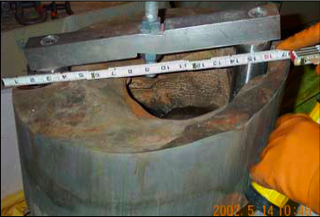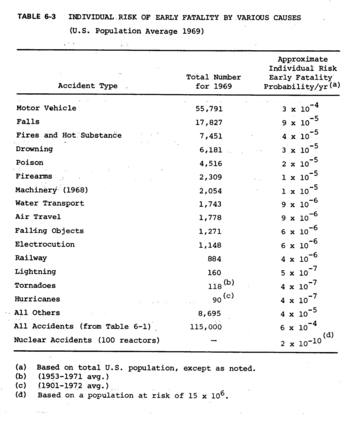
Fault tree analysis (FTA) is a type of failure analysis in which an undesired state of a system is examined. This analysis method is mainly used in safety engineering and reliability engineering to understand how systems can fail, to identify the best ways to reduce risk and to determine event rates of a safety accident or a particular system level (functional) failure. FTA is used in the aerospace, nuclear power, chemical and process, pharmaceutical, petrochemical and other high-hazard industries; but is also used in fields as diverse as risk factor identification relating to social service system failure. FTA is also used in software engineering for debugging purposes and is closely related to cause-elimination technique used to detect bugs.
SAPHIRE is a probabilistic risk and reliability assessment software tool. SAPHIRE stands for Systems Analysis Programs for Hands-on Integrated Reliability Evaluations. The system was developed for the U.S. Nuclear Regulatory Commission (NRC) by the Idaho National Laboratory.

The Nuclear Regulatory Commission (NRC) is an independent agency of the United States government tasked with protecting public health and safety related to nuclear energy. Established by the Energy Reorganization Act of 1974, the NRC began operations on January 19, 1975, as one of two successor agencies to the United States Atomic Energy Commission. Its functions include overseeing reactor safety and security, administering reactor licensing and renewal, licensing radioactive materials, radionuclide safety, and managing the storage, security, recycling, and disposal of spent fuel.

The H. B. Robinson Steam Electric Plant, also known as Robinson Nuclear Plant, is a nuclear power plant located near Hartsville, South Carolina. The plant consists of one Westinghouse 759 MW pressurized water reactor. The site once included a coal-fired unit that generated 174 MW and a combustion turbine unit that generated 15 MW.

The Peach Bottom Atomic Power Station is an American nuclear power plant that is located 50 miles (80 km) southeast of Harrisburg in Peach Bottom Township, York County, Pennsylvania. Situated close to the Susquehanna River, it is three miles north of the Maryland border.

Surry Power Station is a nuclear power plant located in Surry County in southeastern Virginia, in the South Atlantic United States. The power station lies on an 840-acre (340 ha) site adjacent to the James River across from Jamestown, slightly upriver from Smithfield and Newport News. Surry is operated by Dominion Generation and owned by Dominion Resources, Inc.
Probabilistic risk assessment (PRA) is a systematic and comprehensive methodology to evaluate risks associated with a complex engineered technological entity or the effects of stressors on the environment.

The Price-Anderson Nuclear Industries Indemnity Act is a United States federal law, first passed in 1957 and since renewed several times, which governs liability-related issues for all non-military nuclear facilities constructed in the United States before 2026. The main purpose of the Act is to partially compensate the nuclear industry against liability claims arising from nuclear incidents while still ensuring compensation coverage for the general public. The Act establishes a no fault insurance-type system in which the first approximately $15 billion is industry-funded as described in the Act. Any claims above the $15 billion would be covered by a Congressional mandate to retroactively increase nuclear utility liability or would be covered by the federal government. At the time of the Act's passing, it was considered necessary as an incentive for the private production of nuclear power — this was because electric utilities viewed the available liability coverage as inadequate.
CRAC-II is both a computer code and the 1982 report of the simulation results performed by Sandia National Laboratories for the Nuclear Regulatory Commission. The report is sometimes referred to as the CRAC-II report because it is the computer program used in the calculations, but the report is also known as the 1982 Sandia Siting Study or as NUREG/CR-2239. The computer program MACCS2 has since replaced CRAC-II for the consequences of radioactive release.
WASH-740 was a report published by the U.S. Atomic Energy Commission (USAEC) in 1957. This report, called "Theoretical Possibilities and Consequences of Major Accidents in Large Nuclear Power Plants", estimated maximum possible damage from a meltdown with no containment building at a large nuclear reactor.
NUREG-1150 "Severe Accident Risks: An Assessment for Five U.S. Nuclear Power Plants", published December 1990 by the Nuclear Regulatory Commission (NRC) is a follow-up to the WASH-1400 and CRAC-II safety studies that employs the methodology of plant-specific Probabilistic Risk Assessment (PRA). The research team, led by Denwood Ross, Joseph Murphy, and Mark Cunningham, concluded that the current generation of nuclear power plants exceeded NRC safety goals.

The Economic Simplified Boiling Water Reactor (ESBWR) is a passively safe generation III+ reactor design derived from its predecessor, the Simplified Boiling Water Reactor (SBWR) and from the Advanced Boiling Water Reactor (ABWR). All are designs by GE Hitachi Nuclear Energy (GEH), and are based on previous Boiling Water Reactor designs.

Nuclear safety in the United States is governed by federal regulations issued by the Nuclear Regulatory Commission (NRC). The NRC regulates all nuclear plants and materials in the United States except for nuclear plants and materials controlled by the U.S. government, as well those powering naval vessels.
Core damage frequency (CDF) is a term used in probabilistic risk assessment (PRA) that indicates the likelihood of an accident that would cause severe damage to a nuclear fuel in a nuclear reactor core. Core damage accidents are considered extremely serious because severe damage to the fuel in the core prevents adequate heat removal or even safe shutdown, which can lead to a nuclear meltdown. Some sources on CDF consider core damage and core meltdown to be the same thing, and different methods of measurement are used between industries and nations, so the primary value of the CDF number is in managing the risk of core accidents within a system and not necessarily to provide large-scale statistics.

Norman C. Rasmussen was an American physicist.
The State-of-the-Art Reactor Consequence Analyses (SOARCA) is a study of nuclear power plant safety conducted by the Nuclear Regulatory Commission. The purpose of the SOARCA is assessment of possible impact on population caused by major radiation accidents that might occur at NPPs. This new study updates older studies with the latest state-of-the-art computer models and incorporates new plant safety and security enhancements.

The United States Government Accountability Office reported more than 150 incidents from 2001 to 2006 of nuclear plants not performing within acceptable safety guidelines. According to a 2010 survey of energy accidents, there have been at least 56 accidents at nuclear reactors in the United States. The most serious of these was the Three Mile Island accident in 1979. Davis-Besse Nuclear Power Plant has been the source of two of the top five most dangerous nuclear incidents in the United States since 1979. Relatively few accidents have involved fatalities.
Diablo Canyon (Nuclear) Power Plant, located in San Luis Obispo County California, was originally designed to withstand a 6.75 magnitude earthquake from four faults, including the nearby San Andreas and Hosgri faults, but was later upgraded to withstand a 7.5 magnitude quake. It has redundant seismic monitoring and a safety system designed to shut it down promptly in the event of significant ground motion.
Event tree analysis (ETA) is a forward, top-down, logical modeling technique for both success and failure that explores responses through a single initiating event and lays a path for assessing probabilities of the outcomes and overall system analysis. This analysis technique is used to analyze the effects of functioning or failed systems given that an event has occurred.
U.S. non-military nuclear material is regulated by the U.S. Nuclear Regulatory Commission, which uses the concept of defense in depth when protecting the health and safety of the public from the hazards associated with nuclear materials. The NRC defines defense in depth as creating multiple independent and redundant layers of protection and response to failures, accidents, or fires in power plants. For example, defense in depth means that if one fire suppression system fails, there will be another to back it up. The idea is that no single layer, no matter how robust, is exclusively relied upon; access controls, physical barriers, redundant and diverse key safety functions, and emergency response measures are used. Defense in depth is designed to compensate for potential human and mechanical failures, which are assumed to be unavoidable.










